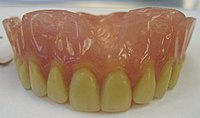
Photo from wikipedia
Palatability and patient acceptability are critical attributes of dispersible tablet formulation. Co-processed excipients could provide improved organoleptic profile due to rational choice of excipients and manufacturing techniques. The aim of… Click to show full abstract
Palatability and patient acceptability are critical attributes of dispersible tablet formulation. Co-processed excipients could provide improved organoleptic profile due to rational choice of excipients and manufacturing techniques. The aim of this study was to identify the most suitable co-processed excipient to use within directly compressible dispersible tablet formulations. Nine excipients, selected based on successful manufacturability, were investigated in a randomised, preference and acceptability testing in 24 healthy adult volunteers. Excipients were classified in order of preference as follows (from most preferred): SmartEx QD100 > F-Melt Type C > F-Melt Type M > MicroceLac > Ludiflash > CombiLac > Pharmaburst 500 > Avicel HFE-102 > Avicel PH-102. Broad differences were identified in terms of acceptability, with SmartEx QD100 being ‘very acceptable’, F-Melt Type C, F-Melt Type M and MicroceLac being ‘acceptable’, Ludiflash, CombiLac and Pharmaburst 500 being ‘neutral’ and Avicel products being ‘very unacceptable’ based on ratings using five-point hedonic scales. Organoleptic differences were ascribed to different composition and physical properties of excipients, resulting in dissimilar taste and mouth-feel. Excipients with particle size in water larger than 200–250 μm were considered poorly acceptable, which supports the use of this value as a threshold for maximum particle size of dispersible formulation. The most promising co-processed excipients for directly compressible dispersible tablets were successfully identified.
Journal Title: AAPS PharmSciTech
Year Published: 2018
Link to full text (if available)
Share on Social Media: Sign Up to like & get
recommendations!